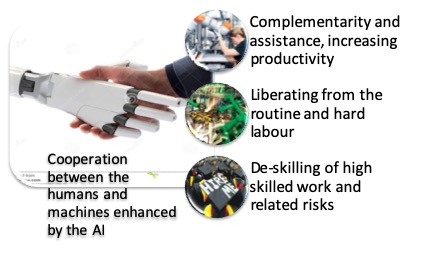2.9 How Can Machines and Humans Work Together?
In seeking to understand the possibilities of cooperation between humans and AI-enhanced technologies, we can raise several key questions:
- What are the new possibilities of such cooperation offered by AI-based technologies?
- What skills are needed for such effective cooperation?

Tuomi (2018) suggests differentiation of the implications of the AI for the work by distinguishing the implications at the level of operations, at the level of acts and at the level of activities. At the level of operations, the AI augments and complements them by increasing the efficiency and effectiveness of current ways of doing things. Integration of intelligent machines and software into the workplace, workflows and workspaces will continue to evolve to enable humans and machines to work together. For example, cashiers become checkout assistance helpers, who can help answer questions or troubleshoot the machines. Warehouse design may change significantly, as some portions are designed to accommodate primarily robots and others to facilitate safe human-machine interaction.
The research of the implications of the Industry 4.0 for the mechanical engineering and electronics sectors in the regions of Bavaria and Baden-Würtenberg executed in 2016 disclosed, that mastering of networked systems with decentralized intelligence, handling data and analysis as well as the ability to safeguard flawless operation of plants are among the most important requirements for work on production sites, together with the management and mastering of traditional skills in the workplace (baymee, 2016). Workflow design will have to be adapted to the more close work of humans with machines by creating a safe and productive environment, what would also make the work more collaborative, increase agility of companies and nonhierarchical management structures.
According Becker (2016) the mechanisms of Artificial Intelligence create completely new spaces for interaction between machines (e.g. multiagent systems), as well as between humans and machines. Pfeiffer (2017; 2018) also notes a significant increase in active labour in the field of complex maintenance processes in heavily digitalized production environments. Increasing complexity of work tends to increase the significance of non-routine activities in the highly automated production processes and requires to subjectify the work actions by holistic perception, to apply explorative and dialogical approaches, intuition, empathetic bearing (Pfeiffer 2017; 2018).
In highly automated plants, the software is the interface for all technical solutions. In this case, all tasks, especially service, maintenance and repair, have been structured around software tasks. Highly qualified technicians are necessary to safeguard this software technological access to plants, while programming is left to the engineers (baymee, 2016).
Shifting of the work demanding high-skills to the lower-skilled workers is enhanced by digital Taylorism. In the survey of Mc Kinsey, 40 percent of companies describing themselves as extensive adopters of automation and AI expect to shift tasks currently performed by high-skill workers to lower-skill ones. It is also related with emergence of the new set of middle-skill, “new-collar” jobs. For example, registered nurses and physician assistants now do some of the tasks that primary care physicians once carried out, such as administering vaccinations and examining patients with routine illnesses.
There is also noticed a “liberating effect” of the AI in the different work processes, for example, the AI driven educational systems provide an excellent complement to a human role in such complex professional fields as teaching, where teachers with the help of AI can focus on the teaching and mentoring that cannot be automated through AI.
Deepening and further resources
This audio provides some insights about the changes in the labour market and jobs brought by the usage of the AI technologies.
This audio contains interesting insights about the cooperation between the workers and AI-enhanced technologies in the work processes.
These videos provide additional insights about the potential of collaboration between the humans and machines.
